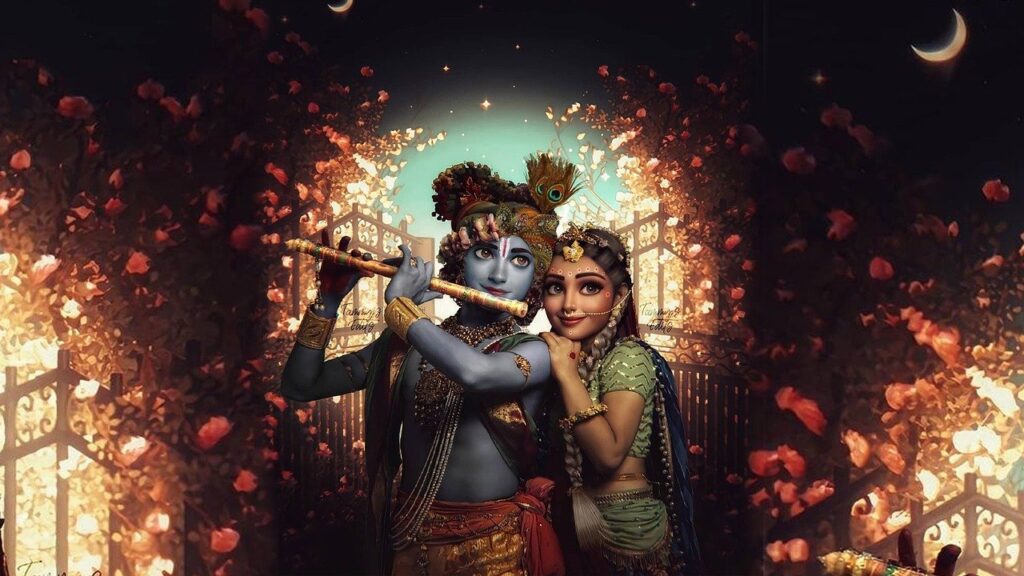
Rasa, or divine mellows, is remarkable and the most esoteric truth. It is the culmination of the transcendental pastimes of Sri Krishna, the Supreme Personality of Godhead. When devotion unto Krishna reaches the peak of purity and grows dynamically active, it transforms into ‘Krishna Bhakti Rasa’, the mellows of devotion towards Krishna.
Unless a devotee attains pure devotion and reaches the stage of a ‘sadhaka’, he is not qualified to experience ‘rasa’. A ‘sadhaka’ is a devotee who has attained attraction for Krishna but might not be completely free from all anarthas (material impurities). A neophyte devotee, however, who engages in deity worship in the temple but behaves improperly with others, is not qualified to relish rasa (divine mellows).
‘Siddhas’ are those devotees whose activities revolve solely around Sri Krishna and who always crave to relish Krishna bhakti rasa. They have attained perfection in their devotional lives either through sadhana (devotional practice), Kripa (mercy of exalted souls or God), or else they are eternally perfected souls (Nitya Siddha).
Krishna is the root cause of divine love whereas Krishna’s personal traits and paraphernalia act as ‘uddipana’ or that which evokes ecstatic love for Him. ‘Uddipana’ helps stimulate the devotee’s latent love for Krishna, which in course of time manifests itself as ‘rasa’.
Divine Love vs Mundane Love
Mundane love is insufficient. It needs the necessary material environment to nourish and flourish. Mundane love declines and slowly disappears when the lovers separate. Mundane love manifests as pleasure when the lovers are together and it emerges painful when the lovers split. However, rasa or mellows of divine love are self-manifest, uninterrupted, and rooted in transcendence. In the case of love towards Krishna, the divine love reaches even greater pinnacles when the lovers are separated. In vipralambha (love in separation), rasa is churned up to produce nectarean bliss. Divine love acquires its peaks when the lovers are separated. Hence rasa cannot be comprehended by mundane intellect because it is transcendental and incomprehensible.
Asta sattvika Vikara – eight ecstatic transformations
When the consciousness of pure devotees bursts with ecstatic emotions of divine love, it is known as ‘sattva’. The range of emotions produced by this state of consciousness is known as ‘sattvika bhava’. These symptoms of sattvika bhava (primarily eight in number) are manifested in one’s external body. They include being stunned (stambha), perspiring (sveda), having the bodily hairs standing on their end (romancha), faltering of one’s voice (svara bheda), trembling (vepathu), fading of the body’s color (vaivarna), tears (asru) and devastation (pralaya).
When a pure devotee experiences sattvika bhava, his consciousness is united with his prana (life energy). The ‘prana’ is then placed in an unnatural condition that causes perturbations in the external body, thereby resulting in the manifestation of symptoms like paralysis, perspiration, etc.

‘Prana’ (life energy) rests upon one’s life air (Vayu). Life air, being air, is also one of the five gross material elements (earth, water, fire, air, ether). Under ordinary circumstances, the life energy moves upon the life air in a balanced manner. However, when the consciousness of a devotee is surged by feelings of divine love, this balance is disturbed and the ‘prana’ becomes predominant. During these conditions, the ‘prana’ mixes with the other gross material elements, apart from the life air (Vayu). When ‘prana’ (life energy) comes in contact with the earth, the symptoms of being stunned (stambha) are manifest; when prana associates with water, tears (asru) of divine love are manifest; when the life energy associates with fire, the symptoms of pallor (vaivarnya) and sveda (perspiration) manifest; when prana associates with ether, the symptoms of swooning or being unconsciousness (pralaya) are manifest.
When the predominating ‘prana’ is situated within its element (air), it gives rise to three different kinds of manifestations. When the mixture of Prana and life air is weak, the manifest symptom is trembling; when the mixture is moderate, it gives rise to the faltering of voice (svara bheda) and when the intensity is very strong, it leads to horripilation (romancha).

Stambha (stunned) – is caused because the devotee experiences one or more of the following emotions: delight, fear, astonishment, dejection, or rage.
Sveda (perspiration) – is caused because the devotee experiences one or more of the following emotions : delight, fear or rage.
Romancha (horripilation) – is caused because the devotee experiences one or more of the following emotions : astonishment, fear, delight, enthusiasm.
Svara bheda (faltering of voice) – is caused because the devotee experiences one or more of the following emotions : lassitude, amazement, wrath, pleasure, fear.
Kampa (shivering) – is caused because of spiritual greed, brought about by fear, anger or delight.
Vaivarna (fading of one’s bodily color) – is caused because the devotee experiences one or more of the following emotions : lassitude, rage and fear.
Asru (involuntary tears) – is caused because the devotee experiences one or more of the following emotions : delight, anger, lassitude.
Pralaya (devastation) – is caused because of overpowering spiritual joy or sorrow that erases consciousness and the ability to act.
Anubhava – Subsequent ecstasy
‘Anubhava’ are the various external manifestations that appear in response to divine ecstasies. ‘Anubhava’ is different from ‘sattvika bhava’ in the sense that sattvika bhava is constitutional whereas ‘anubhava’ follows and supports the sattvika bhava. Anubhavas are subordinate emotions that are generated due to the intervention of the intellect, whereas sattvika bhava is completely independent of any intellectual interventions.
Anubhavas include – Dancing (nrtya), rolling on the ground (vilunthana), singing (gita), lamenting loudly (krosana), stretching and yawning (tanu montana), roaring (hunkara), yawning (jrmbhana), sighing (dirgha svasa), being neglectful of others reactions (lokanpeksita), salivation (lalasrava), laughing loudly (atta hasa), swooning (ghurna) and hiccoughing (hikka).

Anubhava is not the cause of rasa but instead is caused by rasa. For example, when the heart is delighted, the devotee sings, dances, and so on. These expressions of spiritual emotion further nourish the rasa. Both Sattvika bhava and anubhava nourish divine love and vice versa.